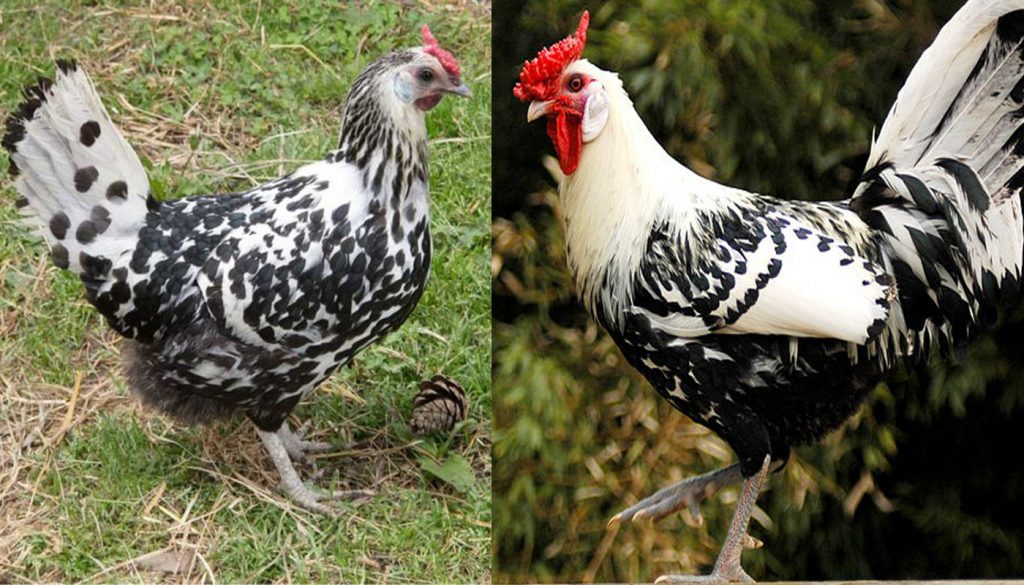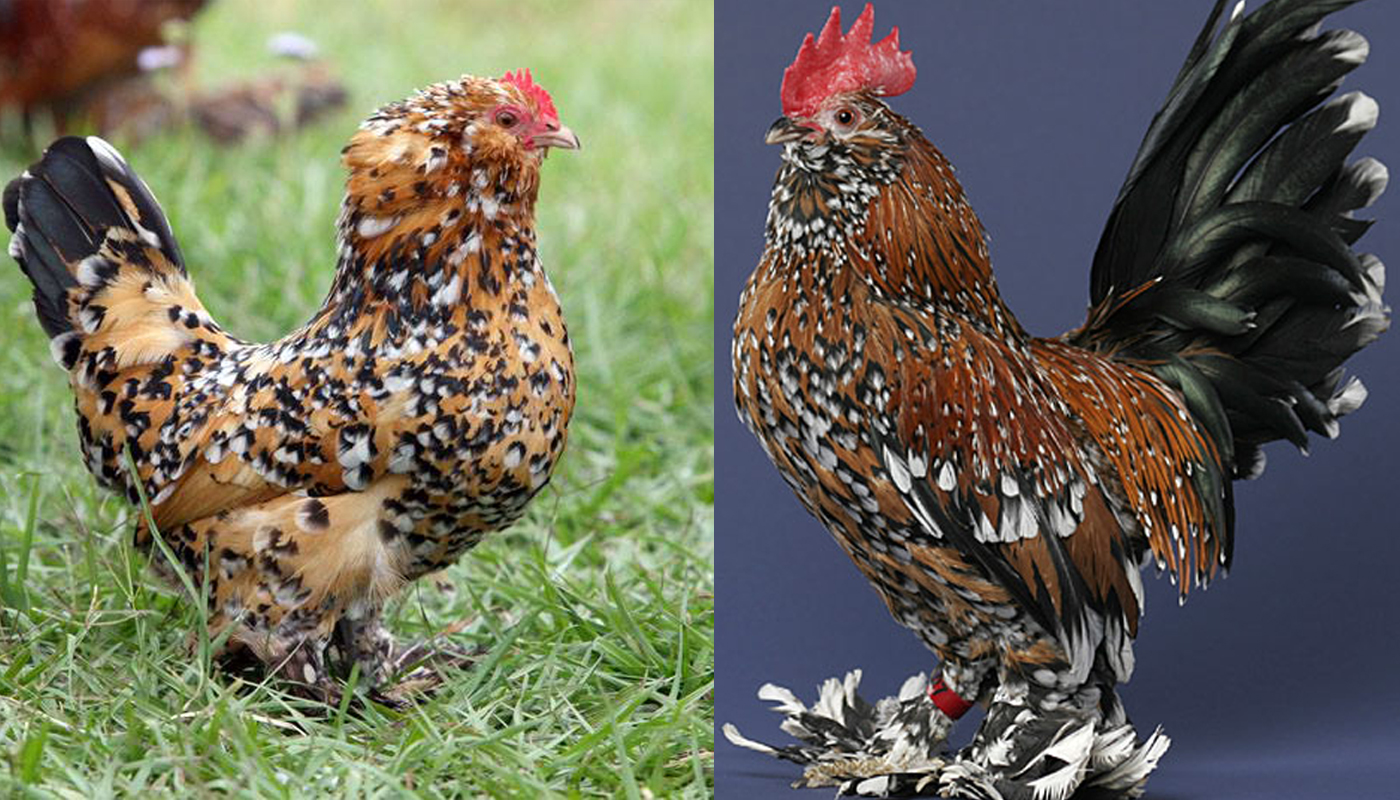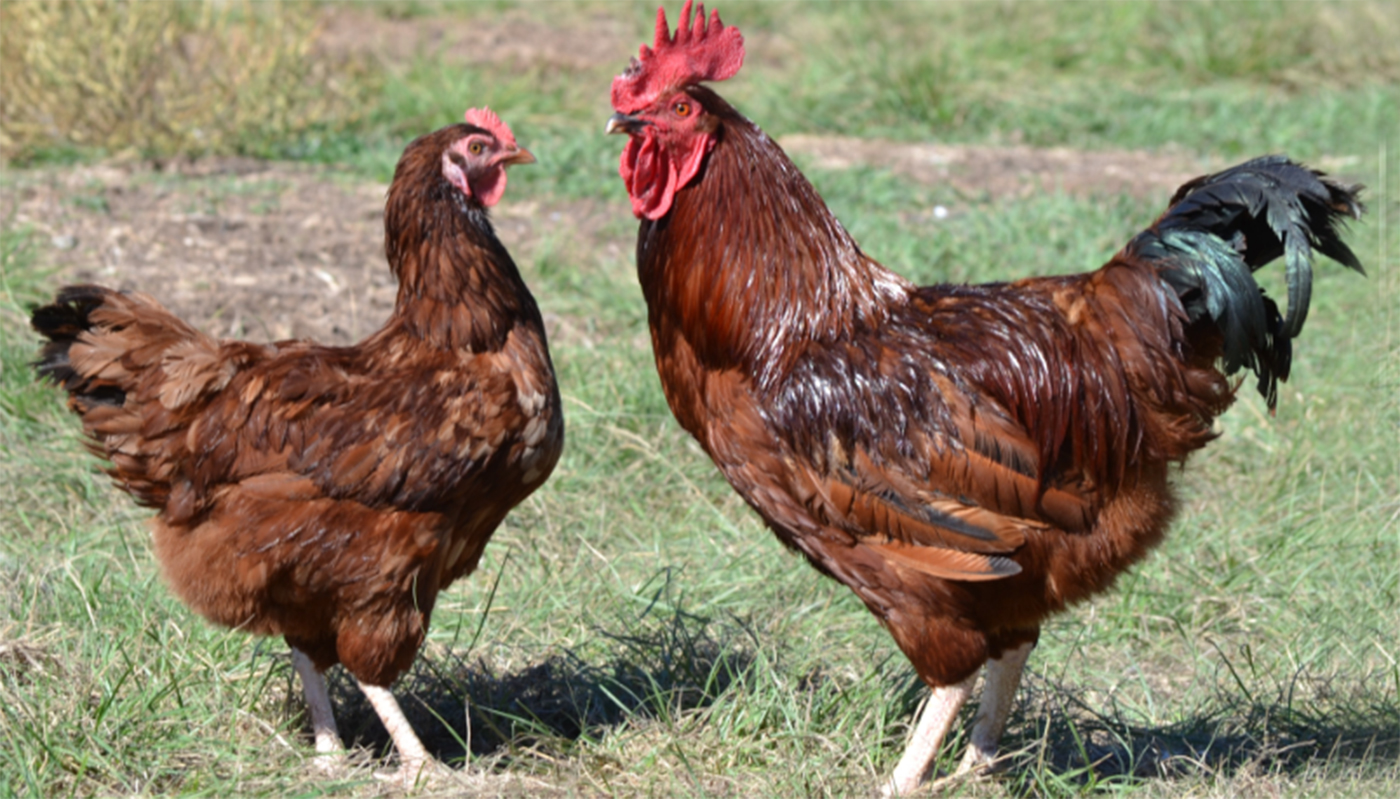
This stately chicken comes with a great backstory and is linked to one of the very first poultry shows.
It is said that in the 1800’s the first poultry show ever was a dispute between two chicken owners in a bar about whose rooster was the most magnificent. With a copper pot as the prize and the bartender as the judge, the competition was on. The roosters that were being argued about were believed to have both been Hamburg chickens.
The hens are known for their great laying ability that continues well through the years unlike other hens that can reach their prime and egg production can drop off. The hens also start to lay at an early age of between four to five months.
They can be quite a flighty bird that enjoys roosting in the higher branches of trees.
| Country of Origin: | Holland |
| American Poultry Association: | Recognized as a breed of chicken in the United States |
| Chicken Category: | Large Breed |
| Chicken Class: | Continental |
| Bantam Variety Available? | Yes – Rose Comb Clean Legged Bantam Classification |
| Good Starter Chicken? | They are a low maintenance chicken with a nature that makes them perfect as a starter chicken. |
PURPOSE⇒ |
Eggs: They are very good egg layers.
They lay medium sized white eggs from 200 – 250 per year They will lay consistently throughout the year and their lifespan They start to lay eggs from around 4 – 5 months old.
Meat: They have white meat, but their dark color bones do not make them a desirable table bird.
Breeding: They can be bred but the hens do not get broody
If you are breeding the Hamburg for show choosing the correct hens and rooster bloodline is crucial.
Foraging: They love to scratch and forage about. They do not enjoy being confined.
Show Bird: Their magnificent plumage in an array of colors and stately bearing make them excellent show birds.
Pets: They can be raised to be friendly but are generally active, flighty and alert chickens.
Other: Not only are the good egg layers but they will spruce up your garden with their beauty.
|
| Flyers? | They are very good flyers |
| Noisy Birds? | They are quite a noisy chicken |
| Interaction with other chickens: | They are not the best at socializing with a lot of breeds. As with any flock if you are introducing new birds it is best to slowly socialize them with the flock. |
| Good with kids? | They can be quite flighty and may be problematic around children |
HISTORY
It is not very clear when Hamburg chickens first arrived in Holland. They were documented to have been there by the fourteenth century where the Dutch then developed them into the breed known as the Hamburg.
The Golden Penciled and Silver Penciled varieties of the breed were developed by the Dutch. It was during the late 1700’s that the breed landed in England where it was revered for its beauty and great egg laying abilities.
It was in the late 1700’s that the English developed the White, Silver Spangled, Black and Golden Spangled varieties of the Hamburg chicken.
The white variety of the bird was, however, shunned by the English but when it made its way to America in around 1856 the white variety was perfected in America.
The breed has been known as many names over the years such as the Yorkshire Pheasant, Silver Pheasant-Fowl of Yorkshire and the Pheasant Fowl.
All of the six Hamburg varieties were accepted into the American Poultry Association Standard of Perfection in 1874.
CHARACTERISTICS |
|
|---|---|
IDENTIFICATION⇒ |
Appearance/Body: These gracefully elegant chickens have flat wide shoulders and a long compact body. Their breasts are well rounded with large strong wings and long sweeping tails. They have white earlobes that are close to their heads and red wattles and combs.
Color(s) Silver Spangled, Silver Penciled, Golden Spangled, Golden Penciled, White and Black
Comb: They have a rose comb
Ave. Weight: Pullet/Hen 3.5 – 4 lbs.
Cockerel/Rooster 4 – 5 lbs. |
| Life Expectancy: | The average lifespan is 8 years |
| Health: | They have no known health issues and are quite a hardy bird. |
| You may Also Like: | HOW TO TELL IS A CHICKEN IS SICK |
| Temperament: | Flighty, active bird that is a bit shy of humans |
| Socialize Behavior? | They tend to shy away from other animals |
| You may Also Like: | HOW TO SOCIALIZING YOUR NEW CHICKENS |
| Known predators: | Most domestic animals leave them alone, but it is always best to keep an eye on dogs and cats. If hawks and or foxes are in your area it is always best to take precautions. Although they are not an easy target for most feathery predators. Check with local animal shelters, zoos, vets, animal control and or pet stores about common predators in your area. |
| Conservation Status: | These birds conservation status is recorded as “watch”. It is best to check on any special license or instructions that may be set up for owning these birds. This can be checked with your local or national conservation centers. |
IDEAL ENVIRONMENT |
|
|---|---|
| Garden Size: | They adapt well to most sized gardens but prefer enough space to free-range. They do not take to confinement well. |
| Ideal Climate: | They are very hardy birds that handle most weather conditions well. |
| Ideal Coop: | The rule of thumb for any coop is 50 cm x 50 cm per hen/rooster in the coop. Ensure there is a good space for the nesting boxes and nightly roosting rails at least 1.5 inches wide. Good ventilation for air but not too drafty especially in winter. It is always a good idea to raise the coop off the ground to give the birds a dry place to roost and lay especially in wet weather. |
| Ideal Coop Run: | Hamburg are excellent flyers and the hens love to roost high in the trees. It is best to completely cover the coop run to keep the birds a safe secure. |
| Ideal Flock Size: | They are quite happy in any size flock, but it is always good to have three or more chickens in your coop. |
| Special Instructions: | They do not have a lot of special requirements. |
| Accessories: | The following accessories are ideal for your coop: Nesting boxes Straw for the boxes and roosting area Roosting rails Perches Water troughs/bowls Food bowls/feeders Heating lamp(s) Animal carrier for transport purposes |
| You may Also Like: | 45 FREE DIY CHICKEN COOP PLANS, TUTORIALS AND DESIGNS |
WHERE TO FIND THESE BIRDS TO ADD TO YOUR FLOCK
They are on the Livestock Conservancy “watch” list and there is not a lot of this breed you will find for sale at some live poultry outlets and farms. You may be able to find them on various internet outlets and hatcheries that advertise on the web. But if you are serious about breeding or showing your chickens it is best to check with your local conservation centers and registered breeders. You can find registered breeders on the Feathers Site website along with a host of valuable information. They will also be able to help with any special requirements, attention or care they may need. If you plan on breeding your chickens, you will want to make sure that they are from a good bloodline.
CARING FOR THE BIRD(S)
Please click here for our full guide to “Taking care of chickens”. This is a comprehensive guide to owning chickens. It covers where to start from choosing your ideal flock, the coop that would best suit your garden, your bird and you to buying and bringing your bird(s) home.
GENERAL
These birds may have a flighty shy personality that may even spook easily but if hand reared and raised correctly the can make really tame pets.
GROOMING
These chickens do love their dust bath and will love some added herbal essences mixed into the loose sand to help with pests and excess feather oils. As they do no really like human attention or being handled look for herbal supplements to put in the sand that will keep pests like mites, lice and various other parasites away. Checking for these pests in their feathers should be done at least once a week to your chickens healthy. Always get your birds de-wormed on a regular basis especially if they are around other animals or interacting with kids.
DIET AND NUTRITION
Give your Hamburg a balanced diet of chicken pellets, grains, chicken mash or grain mix from 8 weeks old and older. This should be fed to them first thing in the morning before they are let out to roam about to ensure they are getting all their nutrients. They are not really big eaters and prefer to eat what they have freshly foraged during the day.
For baby chickens, the best is always Chick Starter when they are under 8 weeks old.
Laying hens should get extra protein and calcium in their diets to ensure the quality of their eggs and to keep them in tip-top health.
Hamburg does love getting table scraps in the form of vegetables and fruit. They find these scraps even better if they are served as ice-cubes on very hot days. Feeding them scraps could be a great way to get them used to be around humans.
Feeding your chickens correctly will give your organic garden a lot of nutritious fertilizer to make your vegetables or flowers grow.
Please see our comprehensive guide to “Feeding your chickens” for more information of the different types of chicken feed for chicks, hens, laying hens, roosters, etc. and where to buy the feed and approximate cost of the feed.
SOCIALIZING THE BIRD(S)
They can be quite a challenging bird to socialize with newcomers or to add to a flock. They are very flighty shy and can be high strung.
Always check on how well a breed will get on with your current flock before buying them as you do not want to upset your coop or stress your current flock.
If you want to introduce another breed with your Hamburg try a breed that has a calm gentle nature that will not stress the Hamburg too much.
As with any newcomer to the roost, you will have to quarantine the bird for 7 – 31 days to ensure it does not have any unwanted critters or disease that could spread to your current flock.
All established flock have a pecking order, so it is advisable to socialize newcomers slowly and determine when it is right to allow them to become a permanent part of the flock.
NOTES / SPECIAL INSTRUCTIONS
As they are registered as a “watch” conservation status they may need an extra license to own or keep in your garden. For advice on what the bird’s conservation status and orders are please check with your local conservation department.
For breeders, it is imperative that you always check your bird’s bloodlines and ensure you are buying your birds from a reputed breeder/farm. In order to sell birds of such stature, they have to be recorded and documented, always check with local animal breeding organizations for these records.
These legitimate documents are also required should you wish to show your bird(s) in various poultry shows/competition showings.
For information and advice on adopting rescued animals, you can visit or contact your local animal welfare center.
Video
USEFUL LINKS
- Caring for your Chicken
- Feeding
- Health
- Socializing your Chicken
- Breeding Chicken
- Raising Chickens A-Z
- Hatching Eggs
- What is Molting
- Animal Shelter (ASPCA)
- American Veterinary Medical Association
- American Poultry Association
- American Animal Welfare Society
- American Animal Control
- American Animal Husbandry Society
References
- https://en.wikipedia.org
- https://livestockconservancy.org
- https://www.roysfarm.com
- https://www.mypetchicken.com
- https://www.backyardchickens.com
- https://www.feathersite.com/
 Crevecoeur Chicken Breed – Everything You Need to Know
Crevecoeur Chicken Breed – Everything You Need to Know All about Pullets, Hens and Eggs
All about Pullets, Hens and Eggs CONDITIONS THAT AFFECT THE EYES OF A CHICKEN
CONDITIONS THAT AFFECT THE EYES OF A CHICKEN Delaware Chicken Breed – Everything You Need to Know
Delaware Chicken Breed – Everything You Need to Know 10 Chicken Breeds for the Colder Climates
10 Chicken Breeds for the Colder Climates Silkie Chicken Breed – Everything You Need to Know
Silkie Chicken Breed – Everything You Need to Know White-faced Black Spanish Chicken Breed – Everything You Need to Know
White-faced Black Spanish Chicken Breed – Everything You Need to Know Cochin Chicken Breed – Everything You Need to Know
Cochin Chicken Breed – Everything You Need to Know Belgian Bearded D’Uccle Chicken Breed – Everything You Need to Know
Belgian Bearded D’Uccle Chicken Breed – Everything You Need to Know MOLTING – WHY, HOW, WHEN AND CAN WE HELP THEM?
MOLTING – WHY, HOW, WHEN AND CAN WE HELP THEM? Rhode Island White Chicken Breed – Everything You Need to Know
Rhode Island White Chicken Breed – Everything You Need to Know